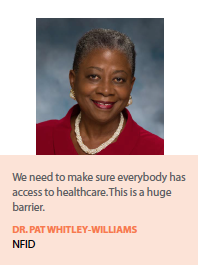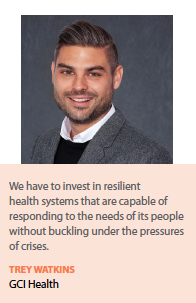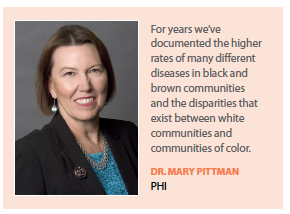Tackling the link between health inequities, social injustice, and social determinants of health.
The World Health Organization describes health as a fundamental human right. Yet, in much of the world, including the United States, health and social inequity are pervasive problems that systematically push already marginalized communities further into poor health.
The national health initiative Healthy People 2020 defines health disparity as particular health differences closely linked with social, economic, and/or environmental disadvantage.
“Health disparities adversely affect groups of people who have systematically experienced greater obstacles to health based on their racial or ethnic group; religion; socioeconomic status; gender; age; mental health; cognitive, sensory, or physical disability; sexual orientation or gender identity; geographic location; or other characteristics historically linked to discrimination or exclusion," Healthy People notes.
“We’ve learned that racism and health inequities are drivers of poor health and are barriers to people being able to gain access to the vital conditions that allow them to be healthy," says Mary Pittman, DrPH, Public Health Institute (PHI) president and CEO. “For years, we have documented the higher rates of many different diseases in black and brown communities, and what we’re seeing now is the lack of response to address the root causes of health disparities really came home to roost with COVID-19."
Barriers to Good Health
 There is a direct link between health inequities, social injustice, and social determinants of health, says Pat Whitley-Williams, M.D., president of the National Foundation for Infectious Diseases (NFID), professor of pediatrics, chief of the Division of Pediatric Allergy, Immunology, and Infectious Diseases, and associate dean of inclusion and diversity at Rutgers Robert Wood Johnson Medical School.
There is a direct link between health inequities, social injustice, and social determinants of health, says Pat Whitley-Williams, M.D., president of the National Foundation for Infectious Diseases (NFID), professor of pediatrics, chief of the Division of Pediatric Allergy, Immunology, and Infectious Diseases, and associate dean of inclusion and diversity at Rutgers Robert Wood Johnson Medical School.
“Where you’re born, where you grow up, where your parents were born, what school district you are in, your access to fresh produce and clean water, where your friends live, are all social determinants of health," Dr. Whitley-Williams says. “And because of the constructs in the United States, people of color tend to live in more impoverished areas, which has a direct impact on health status and access to care."
“Many structural barriers leading people to have higher levels of stress, including access to good education and jobs, contribute to poor health outcomes, which also contributes to a higher incidence of disease," Dr. Pittman adds.
When COVID-19 hit, people who had laptops and access to the Internet were able to flex to working from home, while those whose jobs required interpersonal interaction did not have that option, says Dawn Christian, senior VP, head of inclusion, equity & diversity, at GCI Health.
“As a result, a couple of things happened – businesses drastically cut entire jobs or work hours, workers’ income decreased, and their healthcare benefits were either cut or became unaffordable," she says. “What this demonstrates is that social systems and public health are intertwined. If we do not address the inequities that exist societally, there will be a direct and imminent connection to public health outcomes."
Even the vaccination rollout is geared for those who have Internet access, can read in English, and have transport to vaccination sites, Dr. Pittman points out.
Experts agree that while mobile vans and other strategies are proving very helpful, those solutions need to be available all the time so poorer communities have readily available access to preventive care in their neighborhoods, as well as childhood vaccines and flu vaccines.
To address the effects of social determinants of health (SDoH), sustainable, meaningful public health programs and policies must look comprehensively at an individual’s intersectional experience, comments Trey Watkins, executive VP, global health and corporate responsibility, GCI Health.
Addressing Mistrust and Distrust
 Lack of trust in the healthcare system also contributes to poor outcomes, experts say. This lack of trust has become particularly apparent with the COVID-19 vaccines, where lack of confidence translates to vaccine hesitancy.
Lack of trust in the healthcare system also contributes to poor outcomes, experts say. This lack of trust has become particularly apparent with the COVID-19 vaccines, where lack of confidence translates to vaccine hesitancy.
“People of color are less likely to go immediately to their physician’s office when they have a symptom," Dr. Whitley-Williams says. “In the area of prenatal care, the delay in getting to that first prenatal care visit has a direct impact on a pregnancy outcome, as well as the health of the newborn and infant mortality."
Dr. Whitley-Williams says NFID has been working to educate the public and healthcare professionals about the importance of communication to try to address some of the reasons why people of color mistrust the healthcare system.
“You often hear talk about Tuskegee and the syphilis experiment, and that is deep-rooted, but it’s broader than that," she says. “It has to do with everyday racism in the sense that if someone does not feel their life is valued based on color, that creates mistrust. We work with physicians and nurses, who tend to have most contact with patients in the community, teaching them the importance of listening to the concerns and misconceptions about vaccines and helping the community understand how effective vaccination has been at preventing disease."
Dr. Whitley-Williams notes that she has been a physician for more than 30 years, but, like all physicians, needs to be re-educated from time to time about how to talk to parents about why it’s important to vaccinate everyone in the family against the flu and other viruses.
Mr. Watkins says against the backdrop of the COVID-19 pandemic and the Black Lives Matter movement, the effects of years of systemic racism have come to a head, resulting in continued scepticism and vaccine hesitancy among Black, Indigenous, and People of Color (BIPOC) communities. “Addressing this will take years of dedicated efforts to dismantle systems of oppression and better engage BIPOC in meaningful, trusted ways," he says.
Ms. Christian concurs, saying equity is not a one-size-fits-all approach — it requires intentionality.
“The hesitancy that you see in the BIPOC, Latinx, Indigenous Peoples, and AAPI — Asian Americans and Pacific Islanders — populations around vaccines is not a point of ignorance or a result of being underinformed; rather, it is a point of recall, well-informed by centuries of malpractice," she says. “In order to address inequity head-on we have to be willing to face these uncomfortable truths while, at the same time, honoring the connection of the past to the present conditions. Furthermore, we have to build cultural competencies to better understand not only the outcomes, but the people and their lived experiences. Representation matters—we must include the communities in the process of developing what serves them."
Tackling Health Inequity
 A number of organizations are working to tackle public health equity through various education programs and initiatives to support low-income communities.
A number of organizations are working to tackle public health equity through various education programs and initiatives to support low-income communities.
In addition to developing educational materials, NFID conducts webinars to increase awareness of the importance of infectious disease prevention and treatment. These include webinars aimed at union workers who make up a large part of the essential workforce and typically tend to be the underrepresented minorities, Dr. Whitley-Williams says.
“We’re doing a webinar with Hilton, which has hundreds of thousands of employees all over the world, to educate them and other similar large employers about why it’s important that their employees have good health insurance and that they are vaccinated," she says.
Some states are taking progressive steps to address health equity. The California government has used the Health Places Index to allocate resources based on four quartiles, and has prioritized getting resources to the lowest quartile, Dr. Pittman says.
“Through a PHI program called Together Toward Health, supported through public-private partnerships, funds and support are being offered to community-based organizations who best know the needs of their communities," she says. “With PHI serving as a fiscal intermediary, we have been able to give these organizations some resources so that they can more effectively do what they have historically done and add COVID to their work."
Dr. Pittman cites an example of a volunteer group in Southern California that was not eligible to get state or federal funds, so to run their COVID education program and vaccine support services they were taking money from a youth program that they ran.
“This organization had managed to get 1,200 people vaccinated, and we were able to give them the support they needed to get their youth program running again and continue the vaccine work they were doing," she says.
Separately, government grants have enabled PHI to support food programs. For example, the LA food program (#LetsFeedLA aka Los Angeles CARES Food Security Project) used partnerships with a variety of community-based organizations to provide support via grocery cards or delivery of healthy food boxes. The project reached more than 100,000 individuals, with more than $12 million in grocery food cards and more than $9 million in e-wallet benefits being distributed. More than 200,000 boxes of healthy food were delivered to recipients’ homes, and $1 million in funding was provided to 19 CBOs to register beneficiaries from communities they serve.
As the recipient of the funds, PHI is accountable for vetting organizations, ensuring they are reporting how they use the funds, helping them through challenges, providing any necessary training, and developing a workforce to manage issues such as contact tracing.
“For contact tracing, we have hired people in the community who are bilingual or multilingual and who know the community and the culture," Dr. Pittman says.
Mr. Watkins says the healthcare industry needs to get serious about health, not diseases, about prevention rather than treating illnesses, and recognize that health is not merely the absence of illness.
“Our efforts must be underpinned by equity," he says. “We have to level the playing field to unlock health and well-being in all corners of the world. This starts with deploying our efforts and resources based on burden and need, rather than purchasing power — of governments or individuals. We have to invest in resilient health systems that are capable of responding to the needs of its people — without buckling under the pressures of crises."
According to Dr. Whitley-Williams, barriers such as systemic racism are harder to overcome, but tackling issues such as educating communities so they can make well-informed decisions about their healthcare, and improving access to healthcare are attainable goals.
The Role of Pharma and Beyond
Today’s public health crises are too big and complex for any one company, government organization, or community to solve on its own, so all stakeholders, including the pharmaceutical industry, have a role to play, Mr. Watkins says.
 “The COVID-19 pandemic underscored the power of science and innovation — and it showed just how well the industry’s model can work," he says. “We must harness this momentum — and public trust and expectation — moving forward, coupled with concrete and authentic community engagement, leveraging their value chain and in true partnership with governments and non-governmental stakeholders."
“The COVID-19 pandemic underscored the power of science and innovation — and it showed just how well the industry’s model can work," he says. “We must harness this momentum — and public trust and expectation — moving forward, coupled with concrete and authentic community engagement, leveraging their value chain and in true partnership with governments and non-governmental stakeholders."
Ms. Christian says pharma companies must realize that they are not only suppliers, but curators of healthcare outcomes because of their stream of influence.
“The industry’s relationship with the public starts further up the funnel than at the point of care — it starts at the point of research in spaces like clinical trial design," she says. “What happens there impacts trust, which impacts compliance and adherence. The pharma industry is the voice that informs and, ultimately, drives the decisions made by the entire system — providers, insurers, and patients alike."
Partnering with industry is crucial to successful outcomes, Dr. Pittman says. For example, PHI worked with Abbott, using the company’s rapid antigen test BinaxNOW to help teachers and parents feel secure about schools reopening.
“We trained the staff onsite how to have the children do their own swabbing, and if there was a positive test, then they would send it for a confirmatory PCR test, but because children were in small class pods you didn’t have to shut down the whole school," she says. “Abbott did a lot of education with us about their product and were committed to ensuring we had as many tests as we needed, all offered at cost."
Dr. Whitley-Williams says in addition to developing and manufacturing vaccines that have been critical in tackling COVID-19, pharmaceutical companies have assisted in keeping registries, for instance, for pregnant women who were vaccinated as well as the requirement to conduct post-vaccination monitoring and surveillance.
“It’s also important that they include people of color in clinical trials to boost confidence," she says.
Public health equity extends to putting in place the infrastructure, including funding and incentives, to invest in areas where inequities exist and addressing food scarcity in inner-city neighborhoods, Ms. Christian adds.
“Additionally, food and health education, like preventive care, needs to be a standard within our education systems and at the forefront of medical care," she says. “Often, our society is reacting to something catastrophic. Prioritizing equity would enable us to be prepared to address needs accurately and be more intentional about infrastructure and resource allocation."(PV)
~~~~~~~~~~~~~~~~~~~~~~~~~
NFID Survey Assesses Black Adult Perspectives on Vaccines
The National Foundation for Infectious Diseases (NFID) commissioned a survey of 1,340 U.S. Black adults to better understand beliefs about COVID-19 and flu, as well as attitudes and practices around vaccination.
The survey found that while 55% are worried about either themselves or someone in their family contracting COVID-19, there is considerable hesitancy regarding COVID-19 vaccines among U.S. Black adults. Of those surveyed:
49% plan to get vaccinated against COVID-19 once a vaccine is available to them; however, only 19% of those who plan to get vaccinated intend to do so as soon as possible while 31% prefer to wait.
30% say they do not plan to get vaccinated, while an additional 20% are unsure.
Black adults over age 60 are most willing to be vaccinated, with 68% planning to get a vaccine. However, only 59% of Black women over 60 are willing to get vaccinated compared with 78% of Black men in the same age group.
Among Black adults age 18 to 44 years, 41% do not plan to get a COVID-19 vaccine and 21% are unsure.
33% of Black women (all ages) do not plan to get a COVID-19 vaccine and 22% are unsure.
Only 43% of Black women age 45 to 59 years are willing to get vaccinated, compared with 75% of Black men in the same age group.
Source: NFID, nfid.org
~~~~~~~~~~~~~~~~~~~~~~~~~
Bringing Vaccines and Healthcare to Agricultural Workers
Agricultural farm workers have a critical role to play in the United States. During the COVID-19 pandemic, reaching these workers has been a priority as well as a challenge. In California, most speak primarily Spanish or indigenous languages; many don’t have cars or even computers. They may not be able to take time off from the jobs and income they rely on, or navigate the complex and lengthy sign-up processes necessary to qualify.
Thanks in part to the support of the Public Health Institute’s (PHI) Together Toward Health, the vaccines are coming to them. Together Toward Health funding from PHI has been instrumental in providing additional resources and staffing to eight local community-based organizations that are part of the Desert Healthcare District-led Coachella Valley Equity Collaborative. Through this support, the collaborative is hosting vaccination clinics directly in the Valley’s farmworker communities, providing protection to several hundred farmworkers in a day.
To overcome some distrust of healthcare systems, the initiative, which now includes vaccinations as well as COVID-19 testing and education, relies on trusted community voices. Promotoras (community health workers) trained by the Riverside County Public Health Department are organizing and hosting these events throughout the Coachella Valley in Riverside County, including trailer parks, agricultural fields, and local churches.
Source: Public Health Institute, phi.org
~~~~~~~~~~~~~~~~~~~~~~~~~
Health Inequities
Health inequities are avoidable inequalities in health between groups of people within countries and between countries. These inequities arise from inequalities within and between societies. Social and economic conditions and their effects on people’s lives determine their risk of illness and the actions taken to prevent them becoming ill or treat illness when it occurs.
The social determinants of health are the circumstances in which people are born, grow up, live, work, and age, and the systems put in place to deal with illness. These circumstances are in turn shaped by a wider set of forces: economics, social policies, and politics.
The poorest of the poor, around the world, have the worst health. Within countries, the evidence shows that in general the lower an individual’s socioeconomic position, the worse their health. There is a social gradient in health that runs from top to bottom of the socioeconomic spectrum. This is a global phenomenon, seen in low-, middle-, and high-income countries. The social gradient in health means that health inequities affect everyone.
Source: World Health Organization


















